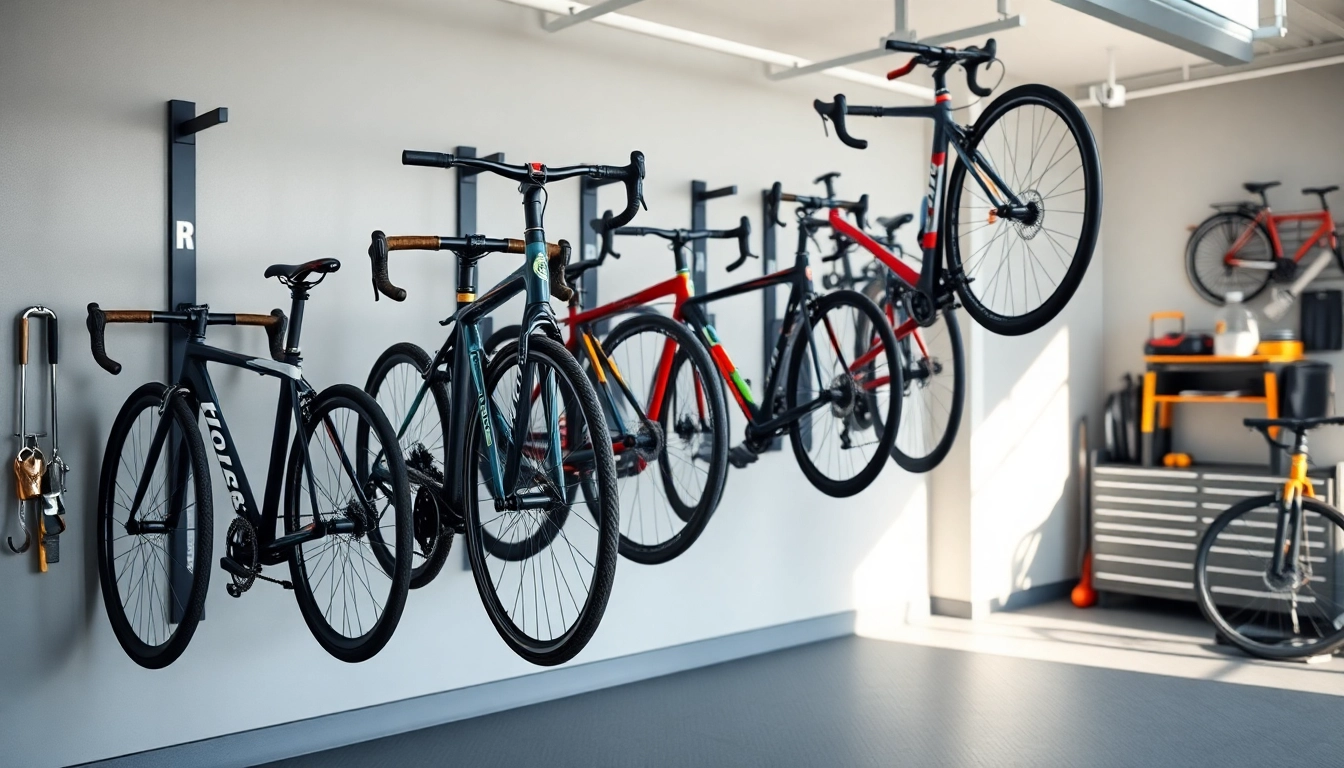Introduction to Wall-mounted Bike Storage
As biking grows in popularity for both recreation and transportation, finding effective storage solutions becomes increasingly essential. Wall-mounted bike storage has emerged as one of the most practical and space-saving options for cyclists. By utilizing vertical space, individuals can keep their bikes organized and accessible while maintaining the cleanliness and aesthetics of their living spaces. In this comprehensive guide, we will explore the benefits, types, installation processes, maintenance tips, and creative ideas for wall-mounted bike storage, providing insights that will help you make informed decisions about your bike storage needs.
Benefits of Wall-mounted Bike Storage
Choosing wall-mounted bike storage offers several advantages that framed both practicality and aesthetics.
- Space Efficiency: By lifting bicycles off the floor and utilizing wall space, it allows for the maximization of usable area within garages, homes, and apartments.
- Access and Organization: Easy access ensures that bikes can be grabbed quickly. Organization systems facilitate easy identification of each bike, reducing time spent fetching them from a pile.
- Protection: Elevating bikes prevents them from being damaged by moisture, dirt, or accidental bumps and falls, extending their lifespan and maintaining their appearance.
- Aesthetic Appeal: Stylish wall-mounted racks can enhance the visual appeal of any interior, allowing bikes to be showcased as functional art pieces.
- Improved Safety: With bikes secured to the wall, there’s less risk of tripping over them, significantly improving safety in tight spaces.
Choosing the Right Wall-mounted Bike Storage
Selecting appropriate wall-mounted bike storage requires consideration of several factors:
- Bike Type: Different bike types, such as mountain bikes, road bikes, and hybrids, may require specific mounting solutions due to their various shapes and frame designs.
- Available Space: Measure the dimensions of the wall and consider ceiling height. Ensure the solution fits well without overcrowding the surrounding area.
- Weight Capacity: It’s crucial to look for systems that can support the weight of the bike, especially heavier e-bikes or fat bikes.
- Ease of Use: Consider how easy it is to place the bike into the storage system and retrieve it. Wall-mounted systems with adjustable arms or hooks may provide added convenience.
Common Mistakes to Avoid
To maximize the benefits of wall-mounted bike storage, avoid common pitfalls:
- Ignoring Weight Limits: Always adhere to manufacturer weight guidelines to prevent potential damage or injuries.
- Inadequate Wall Support: Ensure that you mount the storage solution on a wall that can reliably support the weight, preferably a stud rather than drywall.
- Overlooking Accessibility: Consider how often you will need to use the bikes and position them accordingly for ease of access.
Types of Wall-mounted Bike Storage
Wall-mounted bike storage solutions come in various types, each catering to different needs and preferences:
Vertical vs. Horizontal Storage Solutions
The primary distinction in wall-mounted bike storage is between vertical and horizontal mounts:
- Vertical Storage: Bikes are hung upright, saving space and allowing for other items to be stored beneath them. This option works well in areas with limited horizontal space.
- Horizontal Storage: Bikes are positioned flat against the wall, which can offer a more appealing aesthetic, especially in living spaces. However, it may require more wall area.
Adjustable and Fixed Mounts
Bike storage options also differ based on adjustability:
- Fixed Mounts: These are designed for permanent installation in a designated position. They are often more stable and secure but lack flexibility.
- Adjustable Mounts: Features allow users to alter the positioning to suit various bikes or different storage needs. They are ideal for shared spaces or homes with multiple bikes.
Storage for Different Bike Types
Every bike type has specific requirements that should be considered in your selection:
- Mountain Bikes: These generally feature wider frames and tires which necessitate more robust and possibly heavier-duty storage options.
- Road Bikes: Lightweight and sleek, they benefit from mounts that minimize contact with the frame, protecting delicate components.
- Hybrid Bikes: A blend of mountain and road bike attributes, these may work with both adjustable and fixed mounts depending on personal preference.
Installing Wall-mounted Bike Storage
Proper installation ensures safety, durability, and functionality. Here are considerations for a successful installation:
Choosing the Right Location
Identifying the best location for your wall-mounted bike storage is crucial:
- Look for a wall area with minimal obstructions, ample height, and sufficient clearance for both the bike and the user.
- Check for wall studs or use anchors suited for your wall material to provide the strength necessary for mounting.
Tools and Materials Needed
Before starting the installation process, gather necessary tools and materials:
- Electric or battery-operated drill
- Screws suitable for your mounting system
- Stud finder for identifying wall studs
- Level for ensuring even installation
- Measuring tape to ensure proper spacing
- Pencil or marker for marking positions
Step-by-Step Installation Guide
- Identify and Mark the Wall: Use measuring tape to find the ideal height and spacing, marking drill points with a pencil.
- Locate Wall Studs: Use a stud finder to ensure that you are anchoring the rack to a stud for maximum support.
- Drill Holes: Drill pilot holes through your marked points, ensuring the size is appropriate for your mounting hardware.
- Mount the Rack: Secure your storage solution into the wall, using screws and a level to confirm stability.
- Test the Stability: After installation, attach the bike and gently test the system to ensure it can support the weight and is securely installed.
Maintenance Tips for Wall-mounted Bike Storage
Maintaining your wall-mounted bike storage is essential to ensure it remains functional and safe:
Regular Inspection and Care
Perform routine checks on the mount to ensure:
- The screws are tight and haven’t loosened over time.
- There’s no sign of damage on either the mounting system or the wall around it.
- Moving parts of adjustable systems are functioning appropriately.
Cleaning Tips for Longevity
To maintain both the storage system and the bikes, it’s advisable to keep things clean:
- Wipe down frames and mounts regularly to prevent the accumulation of dust and dirt.
- Use mild cleansers and avoid harsh chemicals that could damage paint or finishes.
Dealing with Common Issues
If you encounter issues such as wobbling mounts or difficulty accessing bikes, consider the following:
- Reassess your installation and tighten any loose screws.
- Adjust the placement if the hook or rack design causes difficulty in accessing the bike.
- Seek replacement parts if any component shows wear or drowsiness due to overuse.
Creative Ideas for Wall-mounted Bike Storage
Innovative designs can incorporate functionality with aesthetics, particularly in smaller spaces:
Incorporating Storage with Home Decor
Use your bike storage system as part of the overall decor:
- Choose racks that have appealing materials and finishes that complement your interiors.
- Consider painting or customizing the storage elements to match your space or highlight certain colors.
Functional and Stylish Design Ideas
Combining utility with style can elevate bike storage:
- Look for multi-functional hooks that can accommodate bags, helmets, and accessories alongside the bike.
- Consider wall-mounted cabinets that can provide a secure storage space for tools and maintenance items, improving organization.
Using Wall-mounted Storage in Small Spaces
For those in apartments or smaller homes, wall-mounted bike storage can help maximize limited space:
- Vertical racks can be installed in entryways or hallways to optimize space without disrupting the flow.
- Hooks can be installed above doors or furniture to capitalize on awkward spaces.




